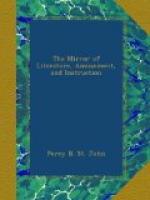20 cents a pound. In our villages we purchase
for our tables the saddle of venison, with the hams
attached, for 37-1/2 cents, which would be something
like one cent a pound.—There are several
ways of hunting deer, all of which are equally simple.
Most frequently the hunter proceeds to the woods on
horseback, in the day-time, selecting particularly
certain hours, which are thought to be most favourable.
It is said, that, during the season when the pastures
are green, this animal rises from his lair precisely
at the rising of the moon, whether in the day or night;
and I suppose the fact to be so, because such is the
testimony of experienced hunters. If it be true,
it is certainly a curious display of animal instinct.
This hour is therefore always kept in view by the hunter,
as he rides slowly through the forest, with his rifle
on his shoulder, while his keen eye penetrates the
surrounding shades. On beholding a deer, the
hunter slides from his horse, and, while the deer is
observing the latter, creeps upon him, keeping the
largest trees between himself and the object of pursuit,
until he gets near enough to fire. An expert
woodsman seldom fails to hit his game. It is extremely
dangerous to approach a wounded deer. Timid and
harmless as this animal is at other times, he no sooner
finds himself deprived of the power of flight, than
he becomes furious, and rushes upon his enemy, making
desperate plunges with his sharp horns, and striking
and trampling furiously with his forelegs, which,
being extremely muscular and armed with sharp hoofs,
are capable of inflicting very severe wounds.
Aware of this circumstance, the hunter approaches
him with caution, and either secures his prey by a
second shot, where the first has been but partially
successful, or, as is more frequently the case, causes
his dog to seize the wounded animal, while he watches
his own opportunity to stab him with his hunting-knife.
Sometimes where a noble buck is the victim, and the
hunter is impatient or inexperienced, terrible conflicts
ensue on such occasions. Another mode is to watch
at night, in the neighbourhood of the salt-licks.
These are spots where the earth is impregnated with
saline particles, or where the salt-water oozes through
the soil. Deer and other grazing animals frequent
such places, and remain for hours licking the earth.
The hunter secretes himself here, either in the thick
top of a tree, or most generally in a screen erected
for the purpose, and artfully concealed, like a mask-battery,
with logs or green boughs. This practice is pursued
only in the summer, or early in the autumn, in cloudless
nights, when the moon shines brilliantly, and objects
may be readily discovered. At the rising of the
moon, or shortly after, the deer having risen from
their beds approach the lick. Such places are
generally denuded of timber, but surrounded by it;
and as the animal is about to emerge from the shade
into the clear moonlight, he stops, looks cautiously
around and snuffs the air. Then he advances a




